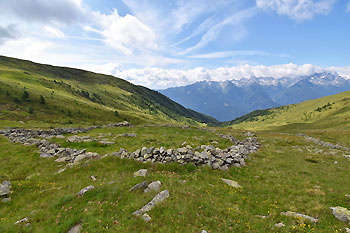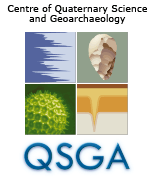Summer at 2300 m a.s.l. in the Italian Alps is nice but short (Fig. 1). Luckily, it’s not too short for some archaeological excavations among rock glaciers and malghas (overnight huts for shepherds). Here in Val di Sole, Trentino, have archaeologists from University of Trento and Newcastle University for nine years been surveying and excavating dry-stone structures related to mountain pastoralism as part of project ALPES (https://r1.unitn.it/alpes/en/). This lucky PhD candidate had the privilege to join for two short field trips to collect samples for rock surface luminescence dating. Working in the mountains is rough. Frequently, during the ascents, I cursed my everyday priorities for Kölsch and Currywurst over jogging and yoghurt. No matter, for the breathtaking landscape and the fascinating archaeological sites make the hike worth it.
Our aim in project F2 in CRC 806 is to develop and apply luminescence rock surface dating in archaeological contexts. The dry-stone structures in Val di Sole (see Angelucci et al., 2014) provide an interesting challenge for the application of the technique. The structures (livestock enclosures, huts and shelters) are built with gneiss boulders from local outcrops. The chronological interpretation is that the oldest enclosure is Bronze Age and the most recent enclosure complexes have been used until the mid-20th century. We collected gneisses from archaeological layers from the Bronze Age enclosure. We also collected gneisses (Fig. 1) from some of the more recent enclosures and calibration samples (exposed for one year), the latter to calculate exposure times for rock surfaces in the enclosures.
References:
Angelucci D.E., Carrer F. & Cavulli F. 2014. Shaping a periglacial land into a pastoral landscape: a case study from Val di Sole (Trento, Italy). Post-classical archaeologies, 4: 125-148
Text: Lucas Ageby
Lucas Ageby is a PhD candidate in the F2-project. He is interested in using luminescence dating of rock surfaces to date archaeological structures and gravel deposits.

























